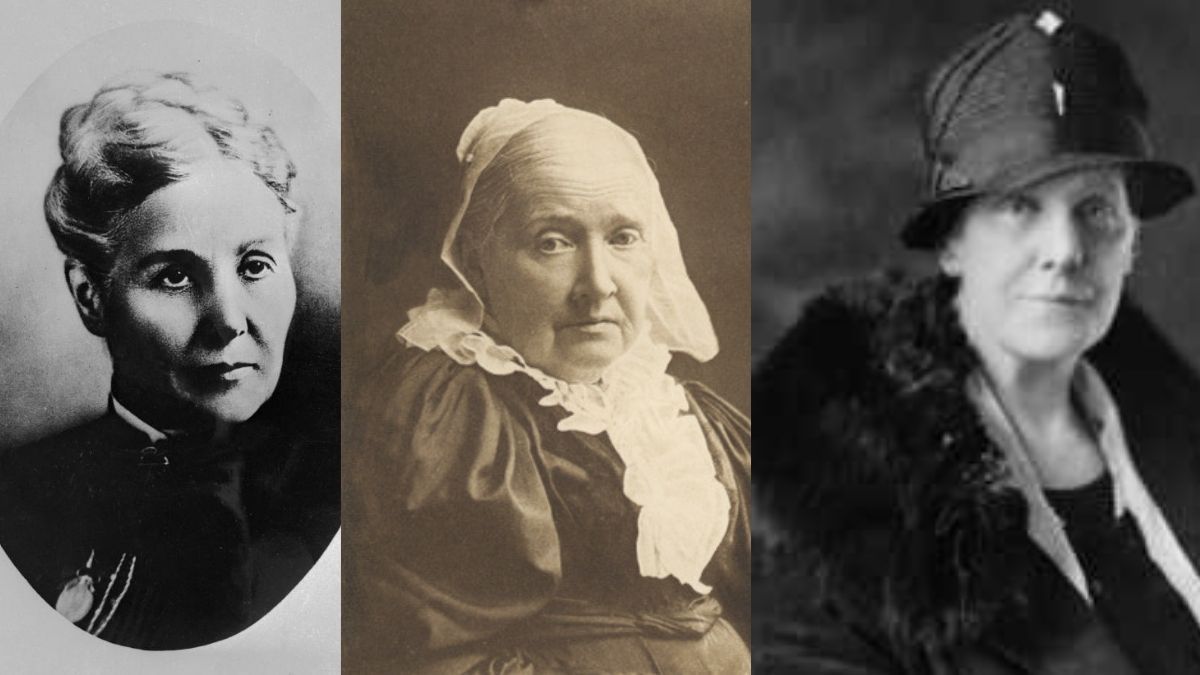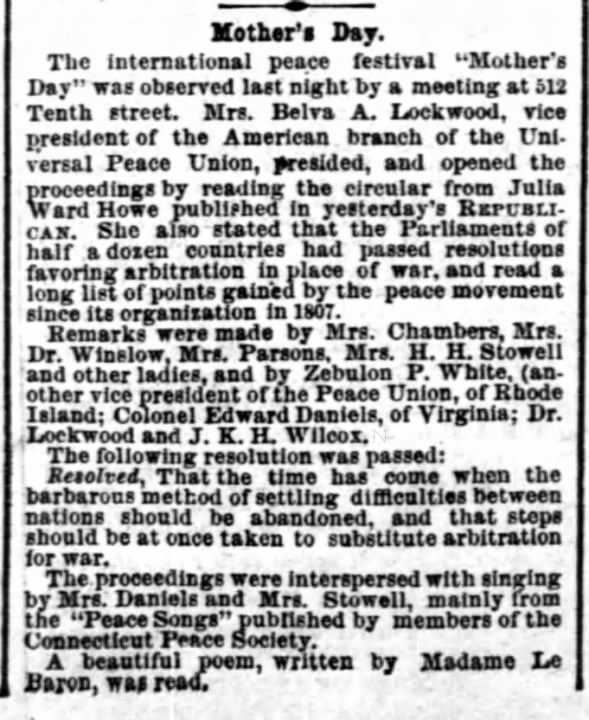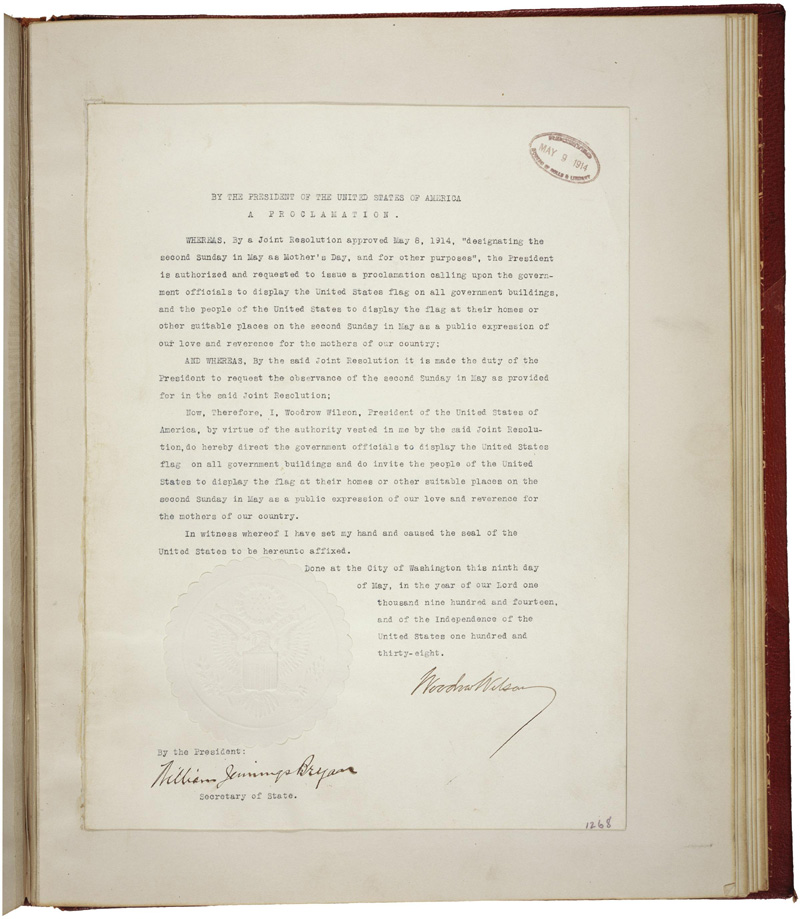For many people, Mother's Day may conjure up images of croissants, mimosas, and brunch on the second Sunday of May, but did you know this holiday can trace its origins back to anti-war efforts in the 1800s? Here's the story of where American Mother's Day began, how it evolved, and why its founder eventually came to disown it altogether.
A Mother's Work
The origins of Mother's Day can be traced back to the 1860s, according to historian Katharine Lane Antolini, when Ann Reeves Jarvis (shown above, left) started Mother's Day Work Clubs in various Appalachian communities in an effort to combat infant mortality rates. Jarvis educated the community about diseases and sanitation and provided access to medicine.
The BBC writes:
Mrs Jarvis had spent her life mobilising mothers to care for their children, says historian Katharine Antolini, and she wanted mothers' work to be recognised. "I hope and pray that someone, sometime, will found a memorial mothers' day commemorating her for the matchless service she renders to humanity in every field of life. She is entitled to it," Mrs Jarvis said.
She was very active in the Methodist Episcopal Church, where, from 1858, she ran Mothers' Day Work Clubs to combat high infant and child mortality rates, mostly due to diseases that ravaged their community in Grafton, West Virginia.
In the work clubs mothers learned about hygiene and sanitation, such as the vital importance of boiling drinking water. The organisers provided medicine and supplies to sick families and, when necessary, quarantined entire households to prevent epidemics.
Jarvis' wish for an official Mother's Day to be established would eventually be fulfilled by her daughter, Anna Jarvis. But before we get to that part of the story, we have to go to Boston in the 1870s.
The Mother's Day Proclamation
In the years following the end of the Civil War in 1865, activist Julia Ward Howe (shown above, center) called on the mothers of the world to help bring peace to an America that had been divided by war. In 1870, Howe wrote an "Appeal to Womanhood Throughout the World," which would later be referred to as the "Mother's Day Proclamation."
Howe, who is perhaps better known for penning the song "The Battle Hymn of the Republic," began her efforts to establish June 2 as "Mother's Peace Day" in 1872. Howe, as well as other activists from the Universal Peace Union, held a number of Mother's Day festivals throughout the late 1800s. Here's a newspaper clipping from one such celebration in 1876:
While Howe was working to establish a Mother's Peace Day, Jarvis' Mother's Day Work Clubs had also taken on a post-war conciliatory goal. The West Virginia Department of Arts, History and Culture writes that when the Civil War ended, Jarvis started organizing "Mothers' Friendship Days" that sought to bring together soldiers, neighbors, and families of differing political beliefs:
Near the end of the war, the Jarvis family moved to the larger town of Grafton. Tensions increased as both Union and Confederate soldiers returned at war's end. In the summer of 1865, Ann Jarvis organized a Mothers' Friendship Day at the courthouse in Pruntytown to bring together soldiers and neighbors of all political beliefs. The event was a great success despite the fear of many that it would erupt in violence. Mothers' Friendship Day was an annual event for several years.
The First Mother's Day
While various events, festivals, and clubs celebrating the power of a mother's love have been celebrated in the United States since the 1860s, it wasn't until a spring day in 1908 that the holiday was celebrated to specifically honor mothers. In fact, it was largely celebrated to honor one specific mother.
Anna Jarvis (shown above, right), the daughter of Ann Jarvis, held the first Mother's Day celebration on May 10, 1908, at the Andrews Methodist Episcopal Church in Grafton, West Virginia. The celebration, which took place three years after Mother Jarvis died, was attended by about 400 people.
Antolini, the author of "Memorializing Motherhood: Anna Jarvis and the Struggle for Control of Mother’s Day," talked to Vox about the origins of the holiday:
[Jarvis] selected the second Sunday in May because it marked the anniversary of her mother's death and she wanted Mother's Day to always fall on the Sabbath. Her vision of motherhood stayed constant through the years for a couple of reasons.
"A lot of it is that Anna herself never marries or has children. She has no idea what motherhood means from the eye of the mother," Antolini says. "It was very much seeing motherhood through the eyes of a child." Jarvis retreated from her mother's socially conscious vision for Mother's Day in favor of one that idolized the mother's individual role.
Jarvis' Mother's Day celebration soon spread to other cities. In 1914, U.S. President Woodrow Wilson issued a presidential proclamation to officially establish Mother's Day as a national holiday.
Wilson invited the American public to display flags "on the second Sunday in May as a public expression of our love and reverence for the mothers of our country."
Flowers, Cards, and Commercialization
In the first few years after Jarvis' 1908 Mother's Day celebration, she promoted the holiday by, for instance, lobbying florists and card companies to promote the holiday. While these efforts largely helped Jarvis achieve her goal of establishing a national holiday, she would later speak out against the commercialization of Mother's Day.
History.com writes:
While Jarvis had initially worked with the floral industry to help raise Mother’s Day’s profile, by 1920 she had become disgusted with how the holiday had been commercialized. She outwardly denounced the transformation and urged people to stop buying Mother’s Day flowers, cards and candies.
Jarvis eventually resorted to an open campaign against Mother’s Day profiteers, speaking out against confectioners, florists and even charities. She also launched countless lawsuits against groups that had used the name “Mother’s Day,” eventually spending most of her personal wealth in legal fees. By the time of her death in 1948 Jarvis had disowned the holiday altogether, and even actively lobbied the government to see it removed from the American calendar.
Jarvis' attempts to de-commercialize the holiday, of course, weren't all that successful. In 2018, the National Restaurant Association found that more than a third of American adults (87 million people) would dine out for Mother's Day. In 2020, the National Retail Federation estimated that more than $28.1 billion would be spent on Mother's Day, with the average person spending more than $200 on gifts, cards, flowers, or special outings.
Mother's Day Around the World
It should be noted that celebrating mothers is not exclusively an American practice. Mothers are celebrated around the world (and on different days) with a wide range of festivals and traditions. Many of these celebrations also predate America's Mother's Day holiday. The United Kingdom, for instance, has been celebrating "Mothering Sunday" on the fourth Sunday of Lent since the 16th century. In ancient Rome, the mother goddess Cybele was also celebrated during Hilaria festivals.



